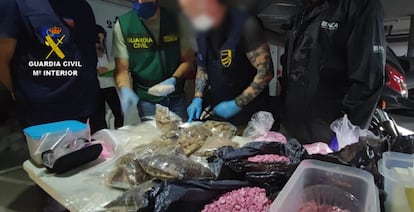‘Pink cocaine’: The expensive and trendy drug is neither cocaine nor high quality
Also known as ‘tusi’ and ‘tucibi’, in Spain it sells for about 100 dollars per gram and is a mixture of cheaper substances such as ketamine and ecstasy


The substance is pink, sometimes smells like strawberries and in Spain goes by different names: tucibi, tusi, pink powder. Most commonly, it is called pink cocaine and considered a luxury drug for affluent people: a single gram costs 80, 90 and even 100 dollars. The same amount of ordinary cocaine costs around 60 dollars, according to a report that the Spanish Observatory on Drugs and Addictions (OEDA in Spanish) published this year. But pink cocaine is neither cocaine nor luxury. Between 2019 and 2022, Energy Control – an organization that works to ensure the safe consumption of narcotics – analyzed 150 samples of pink cocaine. It found dye in almost all of them and cocaine in only two. Most pink cocaine was a cocktail of several cheaper drugs; 44% of the samples contained ketamine, MDMA (ecstasy) and caffeine.
“It’s important to demystify pink coke. In the end, it’s a booming business. They are selling it as something very exclusive, but it is a regular triphasic,” said Berta de la Vega, the coordinator of Energy Control in Madrid, Spain. A triphasic refers to a mixture of ketamine with stimulants such as ecstasy (in this case) or speed, a type of amphetamine. It functions to counteract ketamine’s depressant effects, and it is easy and inexpensive to make. A gram of MDMA costs 40 euros ($42), sometimes a little less, ketamine is around 20 to 35 euros (between $21 and $37), and caffeine powder can be purchased online fairly cheaply. “You take a little bit of each, mix them, add the pink color, a little strawberry smell and, voilà, you sell it for 100 euros. It’s cheaper and safer to buy the substances and mix them yourself,” de la Vega added.
Last summer, Energy Control launched the Tusi: Know What You’re Taking (#TusiSabesLoQueTeMetes) campaign, an initiative to raise awareness about the substances one consumes and the risks of buying one drug while thinking it is something else. That is especially true for mixtures that combine drugs. Some of the samples the organization analyzed even contained crushed acetylsalicylic acid, or common aspirin. De la Vega warned that “if someone does not know what they are taking, it is harder to control the desired effects.” There are more negative consequences: the lows are exacerbated, and the highs are diminished.
In tusi’s case, the risk depends on the proportion of substances in the mixture as well as the other drugs with which it is taken. For example, if a person snorts pink cocaine that has a high ketamine content and also drinks alcohol, that will enhance the depressant effects of both substances, which can lead to loss of coordination, sedation and blackouts. If ecstasy is the main ingredient, taking it with alcohol causes dehydration and increases the risk of heat stroke.
Ignacio, a 25-year-old who lives in Madrid, said that whenever he has taken tusi, his friends have given it to him, so he hasn’t had to pay 90 euros per gram. Before trying it, he was not sure what it was; from what he had heard, it was “a potpourri” of drugs. He asked several acquaintances who regularly did pink cocaine and found out that it was different each time: “Who knows what it contains or what it is made of. The only constant is the color,” he pointed out.
The drug is also always expensive. Ignacio doesn’t usually see pink cocaine that often because it is pricey, he said, but he does not consider the drug to be exclusive to “affluent environments.” Ignacion has “seen it a lot in electronic music venues, especially festivals or big clubs, the same places where one sees other drugs.” He wouldn’t categorize it as a trendy drug, although a few years ago, it was practically never seen, and in the last few months, he has come across it several times at parties. For Ignacio’s friends, at least, it is easy to acquire. They buy it from “ordinary dealers” who sell different drugs, including tusi. Given how costly the substance is, Ignacio was surprised that his friends’ usual dealer gave them “a little bit” on two occasions. When they contacted the dealer to buy pills, he gave them a bag of the pink stuff for free.
Sources at Spain’s National Police say that, until now, it had been “seized mostly in small quantities.” Pink cocaine is routinely sold and consumed in individual bags alongside larger stashes of other drugs, such as cocaine, hashish or heroin. At this point, the sources add, trafficking of the drug is not alarming.
However, last Wednesday, the police announced that they’d broken up a group that was trafficking pink cocaine, as well as ordinary white cocaine, intended for distribution in Malaga, in southern Spain, and the capital Madrid. The drugs were transported by air and arrived in suitcases at Spain’s Adolfo Suárez Madrid-Barajas Airport from Latin America, where the network had collaborators to circumvent inspection of the luggage that contained the drugs. The authorities arrested seven people and seized 24 kilos (almost 53 lbs) of cocaine and 120,000 euros (almost $128,000) hidden in a suitcase at Barajas Airport.
When they searched the homes of the organization’s members, the police confiscated another 26 kilos (57 lbs) of cocaine, along with nearly eight kilos (17 lbs) of pink cocaine, 110,000 euros ($117,320) in cash, nine high-end vehicles and a firearm with 500 cartridges. On October 21, the police also seized pink cocaine and other drugs and arrested 21 people who were distributing it in vehicles configured to store packets of drugs.
Tusi can be purchased in different ways. One common method is popularly known as “telecoke,” a system in which it is delivered to your home: you send a message asking for the drug and quantity you want, it is taken to the address you indicate, you pay and that’s it. But there are also people who sell another substance under the name pink cocaine; it has the same color and is sold at similar prices, but it is completely different from the pink powder that results from mixing several drugs.
This other pink cocaine’s scientific name is 4-bromo-2,5-dimethoxyphenylethylamine, a substance that belongs to the psychedelic phenethylamine family. Alexander Shulgin first produced it in the United States in 1974, and the drug’s effects resemble LSD and ecstasy but are weaker and less stimulating. It is also referred to as nexus or trippy pills. “It is very important to distinguish between the two. The media has used the terms tusi and 2-CB interchangeably. They are not [the same]. 2-CB is a different substance,” De la Vega explained. The OEDA report notes that it is the “third most consumed new psychoactive substance” after ketamine and spice, a synthetic cannabinoid.
María Elena Cogollo, of Spain’s Civil Police drug analysis group, explained that consumption of the drug hasn’t become problematic yet. She noted that “it’s a drug that’s mainly consumed in electronic music venues, nightclubs and parties and raves, primarily in Madrid, the Levant and the Balearic Islands.”
A lack of statistics
Currently, there are no reliable statistics on 2-CB confiscations in Spain, because the drug tests they use in preliminary analyses “do not have a specific coloration for this particular substance.” Cogollo said that the drug is “imported from central European countries, where the major producers of synthetic drugs are located, or manufactured in ad hoc laboratories for each order.” The latter means that the authorities have not seized massive quantities; there’s no large stash of it, and it’s acquired on demand or intended for specific areas.
Another difference between tusi and 2-CB is how the two are processed. “You can make the former at home, while the latter is more complicated. It requires know-how, additional materials, waste management, a series of reagents.... Not everyone can do it,” De la Vega said. Like the mixture of ketamine, MDMA and caffeine, it is also expensive. The Energy Control coordinator believes that many dealers take advantage of the fact that customers confuse one substance with another and sell everything at high cost, regardless of which type of drug it is: “Although it is an unregulated market, capitalist logic is entrenched in it. If something costs less money and they can make a bigger profit, so much the better.”
Tu suscripción se está usando en otro dispositivo
¿Quieres añadir otro usuario a tu suscripción?
Si continúas leyendo en este dispositivo, no se podrá leer en el otro.
FlechaTu suscripción se está usando en otro dispositivo y solo puedes acceder a EL PAÍS desde un dispositivo a la vez.
Si quieres compartir tu cuenta, cambia tu suscripción a la modalidad Premium, así podrás añadir otro usuario. Cada uno accederá con su propia cuenta de email, lo que os permitirá personalizar vuestra experiencia en EL PAÍS.
¿Tienes una suscripción de empresa? Accede aquí para contratar más cuentas.
En el caso de no saber quién está usando tu cuenta, te recomendamos cambiar tu contraseña aquí.
Si decides continuar compartiendo tu cuenta, este mensaje se mostrará en tu dispositivo y en el de la otra persona que está usando tu cuenta de forma indefinida, afectando a tu experiencia de lectura. Puedes consultar aquí los términos y condiciones de la suscripción digital.
More information
Archived In
Últimas noticias
Most viewed
- Sinaloa Cartel war is taking its toll on Los Chapitos
- Oona Chaplin: ‘I told James Cameron that I was living in a treehouse and starting a permaculture project with a friend’
- Reinhard Genzel, Nobel laureate in physics: ‘One-minute videos will never give you the truth’
- Why the price of coffee has skyrocketed: from Brazilian plantations to specialty coffee houses
- Silver prices are going crazy: This is what’s fueling the rally









































